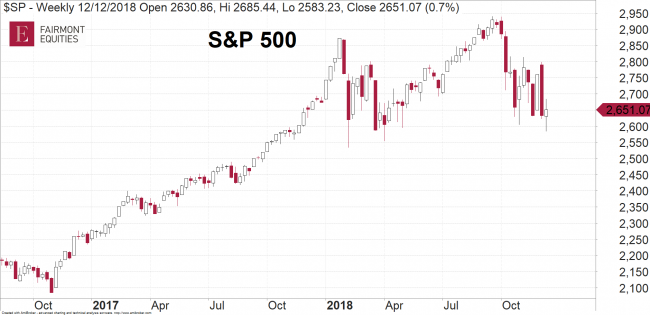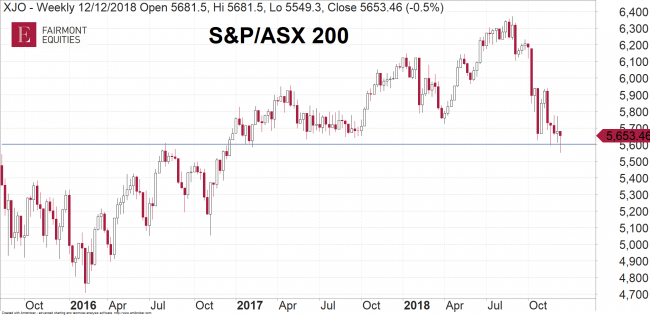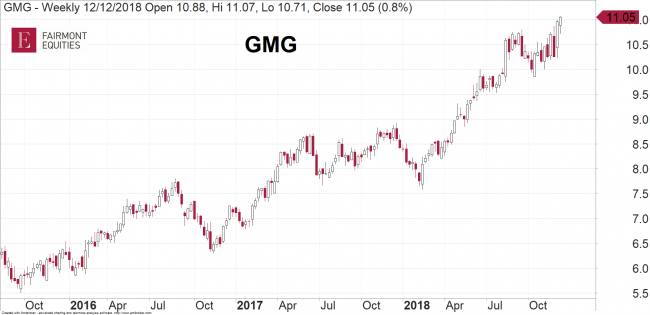US and Australian share markets are down for the year. Rising US 10-year treasury yields have spooked the market. An escalation in trade tensions has further weakened sentiment. The latest worry is now “yield inversion”. The consensus view is leaning towards tough times ahead, a US recession, etc. My view is that the consensus is probably wrong. And the risk is to the upside. Benign inflation, an easing of long-term yields, and GDP growth coming back to sustainable levels should leave equities in a “sweet spot”. This is where growth is not too low and not too high. This means higher stock prices. Do the charts for share markets reveal this to be the case? A few weeks ago I analysed the charts of the S&P 500 and the S&P/ASX 200. I could already see evidence that markets were not going much lower. Has my view changed, and what Australian stock looks like a screaming buy right now?
S&P 500

Despite the noise, the S&P 500 is still in a long-term uptrend. I noted a few weeks ago that “the major support line for the S&P 500 is near the February low, which is just under 2600. As we get closer to that level, the buyers are more likely to step in.” In the last few days, we have seen the S&P 500 dip under that level intraday. A rush of buying then propped it back up, and it continues to hold onto that level. Markets at the moment are still fixated on the negative stories. But from what I can see, the smart money is still buying the dip. For the moment at least, the S&P 500 looks poised for a recovery.
S&P/ASX 200

When you have a market that is heavy in resources and financials, a Banking Royal Commission and trade war with China is never going to be good for business. I am positive on our market and believe it will head higher from here. My commentary a few weeks ago stated “a decent push under 5600 is likely, but that would represent the “peak fear” stage and the market will be susceptible to a strong bounce before Christmas. We should then get another retest of these lows, which would set us up for a more sustainable move.”. So far this week we have seen the market capitulate to levels under 5600. But it then bounced back. So far so good. The next phase is the “rally and retest”. Over time, markets change, economies change, and companies change. The one constant is the human. A bounce in markets here will be good for a few weeks and a few hundred points. However, time and time again, we see the same reaction from investors. That is, the nervous investors sell into that first rally. This leads to a dip, a bit more water under the bridge to sooth the nerves, and then we get a proper recovery. The “sell into the rally” investors watch the market get away from them and they come back in, further pushing it higher. The recent low was achieved only a few days ago, so perhaps I am getting ahead of myself. But the behaviour of investors often repeats itself, which is partially what technical analysis is all about. The end result is that for now I believe the Australian market is going to head higher from here.
My stock pick for right now
A market correction gives you a chance to buy good stocks at cheaper prices. However, what happens if a stock price doesn’t fall? Surely that is a sign of strength? The Goodman Group (ASX:GMG) share price has risen more than 10x since the GFC lows and is trading at a new 52-week high. I believe it has further to go. Some quick fundamentals first. GMG is an industrial property group that provides warehousing and logistics facilities to businesses such as online retailers. Rents are reliable and locked-in, development progress is strong, and gearing is low. With interest rate rises being pushed out further and further, GMG should continue to remain attractive. The chart is one of the strongest on the market. Despite the recent sell off in global equities, GMG is at a 10-year high and momentum remains strong. With solid fundamentals and solid technicals, GMG is a stock that to me is a screaming buy at the moment.

Important: This content has been prepared without taking account of the objectives, financial situation or needs of any particular individual. It does not constitute formal advice. Consider the appropriateness of the information in regard to your circumstances.

